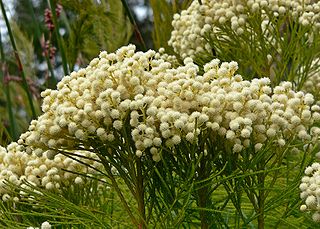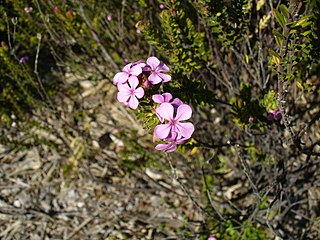
Psoralea is a genus in the legume family (Fabaceae) with 111 species of shrubs, trees, and herbs native to southern and eastern Africa, ranging from Kenya to South Africa. In South Africa they are commonly referred to as fountainbush (English); fonteinbos, bloukeur, or penwortel (Afrikaans); and umHlonishwa (Zulu).

Agathosma is a genus of about 140 species of flowering plants in the family Rutaceae, native to the southern part of Africa. Common names include buchu, boegoe, bucco, bookoo and diosma. Buchu formally denotes two herbal species, prized for their fragrance and medicinal use despite their toxicity. In colloquial use however, the term is applied to a wider set of fragrant shrubs or substitutes.

Melolobium is a genus of flowering plants belonging to the legume family, Fabaceae. It includes 14 species of small shrubs or perennial herbs native to southern Africa, which are found in southern and eastern Namibia, southwestern Botswana, and most of South Africa.

Phylica is a genus of plants in the family Rhamnaceae. It contains about 150 species, the majority of which are restricted to South Africa, where they form part of the fynbos. A few species occur in other parts of southern Africa, and on islands including Madagascar, the Mascarene Islands, Île Amsterdam, Saint Helena, Tristan da Cunha, and Gough Island. Phylica piloburmensis from the Burmese amber of Myanmar, dating to around 99 million years ago during the mid-Cretaceous, was originally described as the oldest fossil member of the genus, but subsequent studies contested its assignment to the genus Phylica and even to the family Rhamnaceae, with one study placing it in the separate genus Nothophylica.

Coleonema is a genus of flowering plants in the family Rutaceae. The eight known species are all from the western Cape Province of South Africa. In Australia, where they are cultivated as garden ornamentals, they are often referred to as Diosma, a different genus in the same family.

Amphithalea is a genus of flowering plants in the family Fabaceae. It belongs to the subfamily Faboideae. It includes 41 species endemic to the Cape Provinces of South Africa.

Berzelia is a genus consisting of 12 species of upright, wiry-stemmed, evergreen shrubs from Cape Provinces in South Africa.

Acmadenia is a genus of flowering plants in the family Rutaceae. The species are mostly from the western Cape Province of South Africa, including:
Euchaetis is a genus of plant in family Rutaceae. It includes 23 species native to the Cape Provinces of South Africa.

Roepera is a genus of flowering plant in the family Zygophyllaceae. It is native to southern Africa and Australia.
Notobubon is a genus of flowering plants belonging to the family Apiaceae.

Zanthoxyloideae is a subfamily of the family Rutaceae. Its most notable member is probably Sichuan pepper.









